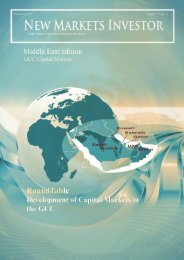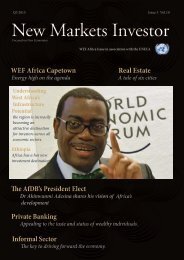Q4 2018 New Markets Investor
The magazine targets an audience of corporate and private investors, but its lucid voice makes it intelligible and essential reading for anybody who wants to understand investment strategies and markets in the 21st century.
The magazine targets an audience of corporate and private investors, but its lucid voice makes it intelligible and essential reading for anybody who wants to understand investment strategies and markets in the 21st century.
You also want an ePaper? Increase the reach of your titles
YUMPU automatically turns print PDFs into web optimized ePapers that Google loves.
Q3 2016<br />
The USD will remain in demand for<br />
some time to come<br />
Simon Derrick,Chief Currency Strategist<br />
BNY Mellon<br />
One of our core beliefs is that the US adopted a policy<br />
of ‘benign neglect” towards the US dollar (USD) somewhere<br />
in late 2001/early 2002 Indeed, the idea that the<br />
US might be prepared to follow such a policy had been<br />
publicly expressed as early as October 2004 by Japans<br />
former vice-finance minister for international affairs,<br />
Eisuke Sakakibara. He told Dow Jones <strong>New</strong>swires that<br />
a “surprisingly large “number of current and former<br />
government and central bank officials he had recently<br />
met in Washington and <strong>New</strong> York seemed to hold the<br />
view that some sort of foreign exchange adjustment:<br />
could be used to address the US twin current account<br />
and budget deficits. He added that Washington might<br />
choose to tolerate a USD fall in a form of “benign<br />
neglect:’ even without explicitly saying that was what it<br />
was doing. Whether or not the US did choose to follow<br />
a policy of benign neglect towards the USD is, in our<br />
opinion, in some ways, irrelevant.<br />
What does matter is that between the start of 2002 and<br />
the summer of 2014 the targeted Fed Funds rate on<br />
average lagged behind the headline inflation rate by 64<br />
basis points (bp). This stood in sharp contrast to the 294<br />
bp average pick up afforded during the Rubin era of the<br />
strong USD that began in the late 1990s.<br />
At its most extreme (September 2011) the Fed Funds<br />
rate stood an astonishing 361 bp below the inflation<br />
rate, a level only previously seen back in 1975.<br />
The impact on the USD was straightforward with the<br />
trade-weighted index falling 38% between the start<br />
of 2002 (when the Fed Funds rate stood 60 bp above<br />
inflation) and the start of September 2011.<br />
The impact of this sustained USD decline on commodities<br />
such as oil and gold, and on a wide range of<br />
currencies was dramatic but easy enough to understand.<br />
Gold rallied by close to 500% against the USD over this<br />
period while Brent Crude gained over 400% (with the<br />
largest gains coming whenever the US looked to ease<br />
monetary policy aggressively). Equally, the FX reserves<br />
of many emerging and developing nations soared as<br />
they either stepped into the market on a regular basis to<br />
fight against currency strength or enjoyed the benefits<br />
-73-<br />
<strong>New</strong> <strong>Markets</strong> <strong>Investor</strong>









